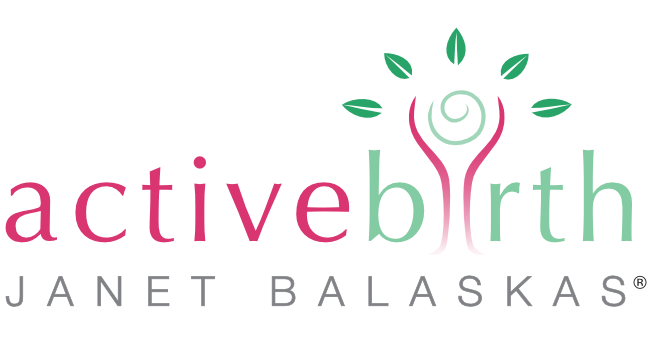Thanks to Olivia for this question. She is in early pregnancy and exploring her options about where she wants to give birth
What is the ideal environment for an Active Birth?
The most important factor in the space you will be giving birth is that you feel safe, relaxed, and have a sense of privacy. For some women this means giving birth in their own home and for others it may be in a birth centre or a hospital. It depends on lots of factors. You will get a feel of where you want to be when you get closer to the birth. And you can change your mind!
Who will be with you
This is perhaps the first consideration. Midwives are not usually able to be with you all the time, so it’s wise to have a birth companion you feel very comfortable with. This could be your partner, a close friend or relative, or a professional doula. It’s ideal if this person (and more than one may be too many!) is involved with your birth preparation or gets to know you very well in pregnancy and has a clear idea of what your wishes are for your birth. If your life partner will be there, it can make a huge difference if he or she understands the birth process and how to support you, as well as when to step back and let you get on with it. It can be a very intense and challenging experience to be the birth partner – especially for the first time. Often the partner has the role of helping to communicate your wishes and needs to your carers – so it helps to be prepared with some good basic information. In my workshops and courses, I pay a lot of attention to partners and do my best to empower and inform them. They often tell me they came reluctantly feeling anxious, and left feeling confident and looking forward to the experience.
Keep your options open
I’m not a great believer in women being alone in labour, but some women prefer their birth partner to be nearby, but at a discreet distance – knowing they can be summoned at any time. Others like to be in close contact, to be held and touched, so there is a feeling of doing it together. It’s good to talk about it, learn some skills and keep options and possibilities open! So, give some careful thought to who will be there – bearing in mind that anyone who is with you has confidence in you, is relaxed, well informed and understands the motto ‘do not disturb, do not observe, do not distract.’
The room itself needs to have a feeling of intimacy and homeliness and to feel like your own space where you have a sense of personal control. The ability to dim the lighting is important to create the best ambience for a birth.
A safe and satisfying birth experience depends on keeping the birth space anxiety and stress free.
For many women, a hospital birth environment is unfamiliar and provokes fear and anxiety. This can interrupt the delicate neuro-hormonal influences that drive labour and birth and inhibit physiological processes. This is why midwife led birth units and birthing centres reflect an understanding of the calm , semi-dark and homely space women need in labour.
These are the essentials and when they are in place, an active birth can happen in almost any environment.
What about the design and furnishings?
A space is needed that will facilitate the physiology of labour and birth. You will need to be able to adopt a variety of upright positions. A few simple props will do, such as a mat on the floor, a beanbag, birth ball and plenty of cushions (you can buy some cheap cushions and can bring these yourself and throw them away after if they get messy). A horseshoe shaped birthing stool is a useful prop to make squatting more comfortable.
Also, a comfortable place for your birth partner to lie down to relax is important, especially if the labour is long or goes through the night. Some birth centres have a double bed, but some partners I know simply take an exercise mat to roll out on the floor.
Of course, a birthing pool is a wonderful feature to aid relaxation, especially in strong labour and some birth centres have one in every room. In some hospitals there are labour rooms on the general labour ward which may be equipped like a birth centre, including a birth pool, for women who need to be in closer proximity to medical support but still want to be mobile and active. It’s always worth asking!
Luxury is great and some birthing centres do look and feel like luxury hotel rooms. However, this is not a priority – more a bonus! Kind, caring, sensitive support and space to move around is what is most important.
Clocks and watches are not helpful as there is a sense of timelessness in a birth and it is better for the mother not to be aware of time. Mobile phones and devices are best kept out of the room, ideally switched off until after the birth. So, partners don’t forget to take a good book!
Midwifery routines:
When you visit your midwife for a check-up in late pregnancy you can ask whether they use hand-held dopler heart monitors to listen in to baby. These are most suitable for an Active Birth as they allow for freedom of movement. Ask about the frequency that these important checks are carried out. It may be as often as every 15 or 30 minutes, but certainly will be hourly. Relax as much as possible when this is happening, breathe deeply and ‘check in’ inwardly with your baby.
Internal checks of cervical dilation (0 -10cms) are done much less frequently – usually 4 hourly. Ask if these can be done in upright positions or whichever position you happen to be comfortable in.
This quote comes from the website ‘Evidence Based Birth’ which is a great resource for research about birthing practises:
‘There is growing evidence that birth spaces can be designed to feel safe and calming, and that these are associated with reduced intervention rates, good clinical outcomes and positive birthing experiences for women.’
Disclaimer
Active Birth is designed for mothers who wish to give birth naturally and have had a healthy pregnancy and no medical complications during labour and birth. Aspects of an Active Birth can also sometimes be used in combination with medical interventions. The website and newsletters offer general information only. They are not a substitute for the professional advice, diagnosis or treatment offered by your midwives or doctors. The Active Birth Centre/ Janet Balaskas in general, accept no liability for the guidance herein, and advise that you do not disregard professional medical advice and inform yourself with other trusted evidence-based sources of information when making your decisions.

